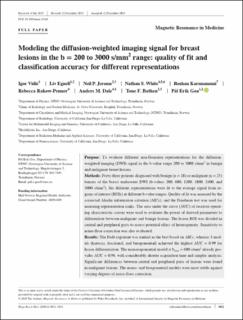| dc.contributor.author | Vidic, Igor | |
| dc.contributor.author | Egnell, Liv Elisabet | |
| dc.contributor.author | Jerome, Neil Peter | |
| dc.contributor.author | White, Nathan | |
| dc.contributor.author | Karunamuni, Roshan | |
| dc.contributor.author | Rakow-Penner, Rebecca | |
| dc.contributor.author | Dale, Anders M. | |
| dc.contributor.author | Bathen, Tone Frost | |
| dc.contributor.author | Goa, Pål Erik | |
| dc.date.accessioned | 2021-05-10T06:35:39Z | |
| dc.date.available | 2021-05-10T06:35:39Z | |
| dc.date.created | 2021-01-14T21:06:05Z | |
| dc.date.issued | 2020 | |
| dc.identifier.citation | Magnetic Resonance in Medicine. 2020, 84 (2), 1011-1023. | en_US |
| dc.identifier.issn | 0740-3194 | |
| dc.identifier.uri | https://hdl.handle.net/11250/2754470 | |
| dc.description.abstract | Purpose
To evaluate different non‐Gaussian representations for the diffusion‐weighted imaging (DWI) signal in the b‐value range 200 to 3000 s/mm2 in benign and malignant breast lesions.
Methods
Forty‐three patients diagnosed with benign (n = 18) or malignant (n = 25) tumors of the breast underwent DWI (b‐values 200, 600, 1200, 1800, 2400, and 3000 s/mm2). Six different representations were fit to the average signal from regions of interest (ROIs) at different b‐value ranges. Quality of fit was assessed by the corrected Akaike information criterion (AICc), and the Friedman test was used for assessing representation ranks. The area under the curve (AUC) of receiver operating characteristic curves were used to evaluate the power of derived parameters to differentiate between malignant and benign lesions. The lesion ROI was divided in central and peripheral parts to assess potential effect of heterogeneity. Sensitivity to noise‐floor correction was also evaluated.
Results
The Padé exponent was ranked as the best based on AICc, whereas 3 models (kurtosis, fractional, and biexponential) achieved the highest AUC = 0.99 for lesion differentiation. The monoexponential model at bmax = 600 s/mm2 already provides AUC = 0.96, with considerably shorter acquisition time and simpler analysis. Significant differences between central and peripheral parts of lesions were found in malignant lesions. The mono‐ and biexponential models were most stable against varying degrees of noise‐floor correction.
Conclusion
Non‐Gaussian representations are required for fitting of the DWI curve at high b‐values in breast lesions. However, the added clinical value from the high b‐value data for differentiation of benign and malignant lesions is not clear. | en_US |
| dc.language.iso | eng | en_US |
| dc.publisher | Wiley | en_US |
| dc.rights | Navngivelse-Ikkekommersiell 4.0 Internasjonal | * |
| dc.rights.uri | http://creativecommons.org/licenses/by-nc/4.0/deed.no | * |
| dc.title | Modeling the diffusion-weighted imaging signal for breast lesions in the b = 200 to 3000 s/mm 2 range: quality of fit and classification accuracy for different representations | en_US |
| dc.type | Peer reviewed | en_US |
| dc.type | Journal article | en_US |
| dc.description.version | publishedVersion | en_US |
| dc.source.pagenumber | 1011-1023 | en_US |
| dc.source.volume | 84 | en_US |
| dc.source.journal | Magnetic Resonance in Medicine | en_US |
| dc.source.issue | 2 | en_US |
| dc.identifier.doi | 10.1002/mrm.28161 | |
| dc.identifier.cristin | 1871647 | |
| dc.description.localcode | © 2020 The Authors. Magnetic Resonance in Medicine published by Wiley Periodicals, Inc. on behalf of International Society for Magnetic Resonance in Medicine | en_US |
| cristin.ispublished | true | |
| cristin.fulltext | original | |
| cristin.qualitycode | 2 | |

